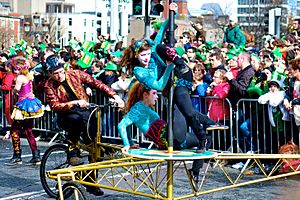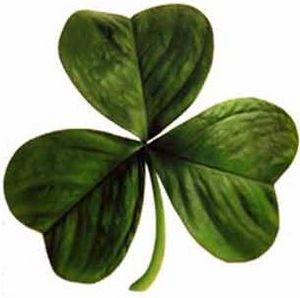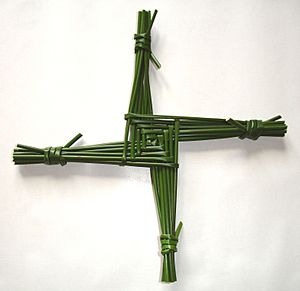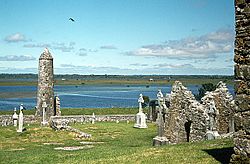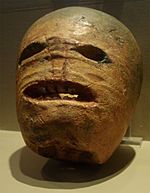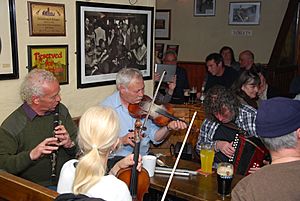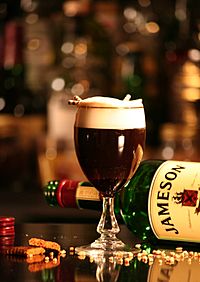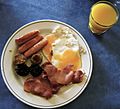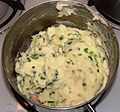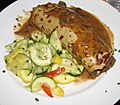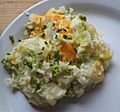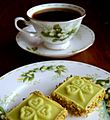Culture of Ireland facts for kids
The culture of Ireland is all about the special customs, traditions, and ways of life of the Irish people. It includes their language, music, art, stories, food, and sports. For a long time, Irish culture was mostly Gaelic. But it has also been shaped by people from England and Scotland over hundreds of years.
Today, there are some differences in culture between people who are Catholic and those who are Protestant, especially in Northern Ireland. Because many Irish people have moved to other countries, Irish culture is now celebrated all over the world. Big festivals like Saint Patrick's Day and Halloween are good examples of this!
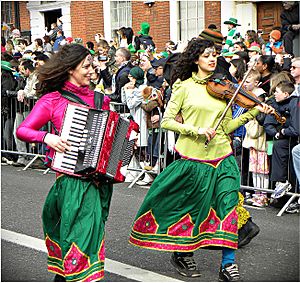
Contents
Holidays and Fun Festivals
The Irish calendar still follows many old customs from ancient times, mixed with Christian traditions. Christmas in Ireland has unique local traditions. On December 26th, which is Saint Stephen's Day, groups called "Wrenboys" go from door to door in costumes with musicians. They "hunt the wren" (pronounced "ran") and entertain people for food or drinks. This tradition is very old and is believed to bring good luck.
Birds are special in Celtic stories. The tiny wren was even thought to be a messenger between worlds.
Saint Patrick's Day
Ireland's national holiday is Saint Patrick's Day on March 17th. It's celebrated with parades and festivals across Ireland and by Irish people worldwide. This day honors Saint Patrick, who is the patron saint of Ireland.
A famous story says Saint Patrick chased all the snakes out of Ireland. This is a way of saying he helped bring Christianity to the island. Snakes were symbols of evil or old pagan ways. He also taught people about the Trinity (three divine persons in one God) using a shamrock, which is a three-leaf clover.
The Twelfth of July
In Northern Ireland, July 12th is a public holiday called The Twelfth. It celebrates the victory of William III at the Battle of the Boyne. This holiday is mostly celebrated by Irish Protestants in Northern Ireland. They have many colorful parades organized by the Orange Order. These parades feature special banners, sashes, and music from marching bands playing traditional songs.
Other Ancient Festivals
Brigid's Day on February 1st (also called Imbolc or Candlemas) is another old festival. It marks the start of spring and was celebrated before Christianity came to Ireland. People often make St. Brigid's Crosses from rushes.
Other ancient Celtic festivals are still remembered in the names of Irish months:
Samhain is now widely known as Halloween. It's celebrated all over the world, including in the United States. It's followed by All Saints' Day, a Christian holiday.
Religion in Ireland
Christianity is the most common religion in Ireland, including both Roman Catholicism and Protestantism. Christianity arrived in Ireland around the 5th century. Its early history is closely linked with Saint Patrick, who is Ireland's patron saint. The Celtic festival of Samhain, which we now call Halloween, started in Ireland and is celebrated globally. Religion has always been very important in Ireland.
Irish Folklore and Legends
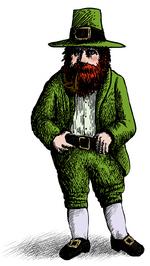
The Leprechaun is a very famous character in Irish folklore. Stories say leprechauns are mischievous fairy-like creatures dressed in green. They spend their time making shoes. Leprechauns are also said to hide a pot of gold at the end of a rainbow. If you ever catch one, it can grant you three wishes to be set free!
More respected in Ireland are the stories of Fionn mac Cumhaill. Legend says he built the Giant's Causeway as stepping-stones to Scotland so he wouldn't get his feet wet. Another tale says he once scooped up part of Ireland to throw at a rival. He missed, and the clump became the Isle of Man, while the pebble became Rockall. The hole he left became Lough Neagh.
The Irish king Brian Boru is also part of many historical stories. He ended the rule of the High Kingship of Ireland by the Uí Néill. Many old Irish legends were written down by Lady Gregory. These stories often show the special power and status that Celtic women had long ago.
Halloween in Ireland
Halloween is a very old and popular holiday in Ireland, celebrated on October 31st. The name "Halloween" comes from "All-Hallows-Eve." Some historians believe it started from the Gaelic festival Samhain. The Gaels thought that on this night, the line between this world and the otherworld became thin, allowing the dead to visit the living world.
Traditional Halloween customs in Ireland include:
- Children dressing in costumes and going door-to-door for food or coins.
- Hollowing out and carving turnips into lanterns with faces.
- Playing games like apple bobbing at parties.
- Lighting bonfires and having firework displays.
Irish and Scottish people moving to North America in the 1800s helped make Halloween popular there.
Literature and the Arts
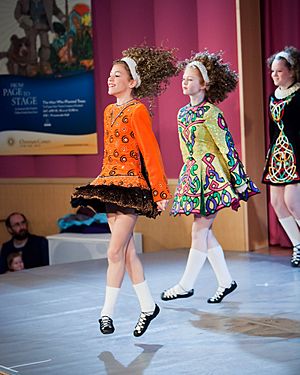
Ireland, though a small island, has given a lot to world literature. Famous writers include James Joyce, Bram Stoker, Jonathan Swift, and Oscar Wilde. Ireland also has four winners of the Nobel Prize in Literature; William Butler Yeats, George Bernard Shaw, Samuel Beckett, and Seamus Heaney. Three of these Nobel winners were born in Dublin, making it a city with more Nobel literary winners than any other.
The Irish language has the third oldest literature in Europe. It has the most important collection of written works (both old and new) of any Celtic language. There's also a strong tradition of spoken legends and poetry. The earliest Irish poetry dates back to the 6th century.
Irish visual art began with ancient carvings at places like Newgrange. It continued with beautiful gold objects from the Bronze Age, and then Celtic brooches and illuminated manuscripts from the early Middle Ages. In the 19th and 20th centuries, a strong tradition of painting grew, with artists like John Butler Yeats and Jack Yeats.
Irish folk music and dance are also very well known. In the mid-1900s, traditional Irish music became less popular, especially in cities. Young people were more interested in jazz and rock and roll from Britain and the United States. However, in the 1960s, there was a new interest in traditional Irish music. The annual Fleadh Cheoil na hÉireann is the biggest festival of Irish music in Ireland.
Later, bands like Horslips, Van Morrison, and Thin Lizzy started mixing traditional music with rock to create a new sound. Today, bands like U2, Snow Patrol, The Cranberries, and The Corrs continue to blend traditional and modern styles.
- Irish Nobel Prize in Literature laureates
| W.B. Yeats (1865–1939) |
George Bernard Shaw (1856–1950) |
Samuel Beckett (1906–1989) |
Seamus Heaney (1939–2013) |
|---|---|---|---|
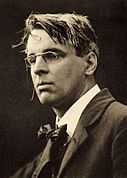 |
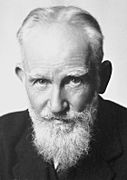 |
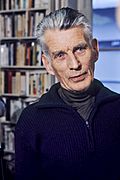 |
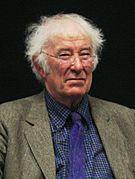 |
Languages Spoken in Ireland
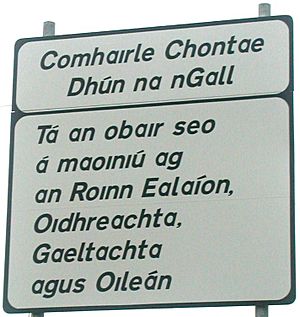
Irish and English are the most common languages in Ireland. English is spoken by most people. Irish is the first language for only a small number of people, but many more speak it as a second language. About 40% of people in the Republic of Ireland say they can speak some Irish.
Other languages are also spoken, especially by immigrants. For example, Polish is now the second most spoken language in Ireland after English, with Irish being the third. Shelta is a mix of Irish, Romany, and English, spoken by Irish Travellers. There are also two sign languages developed in Ireland.
- Irish Gaelic Language
- Irish Sign Language
- Hiberno-English
- Ulster Scots language
- Mid-Ulster English
- Northern Ireland Sign Language
- Shelta language
Food and Drink in Ireland
Food in Early Ireland
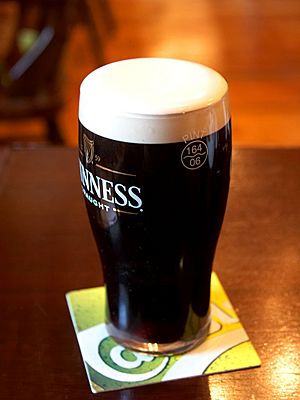
Old Irish stories talk a lot about food and drink. Honey was eaten a lot and used to make mead, an alcoholic drink. There are also many mentions of fulacht fia sites. These are old cooking places where people would boil water in holes in the ground using hot stones to cook venison (deer meat). Many fulacht fia sites have been found across Ireland.
When archaeologists dug up the Viking settlement in Dublin, they found out a lot about what people ate. The main animals were cattle, sheep, and pigs, with pigs being the most popular. Poultry, wild geese, fish, and shellfish were also common. People ate many native berries and nuts, especially hazel nuts. Seeds from plants like knotgrass were also found and might have been used to make porridge.
The Potato in Ireland
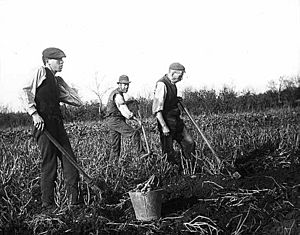
The potato came to Ireland in the late 1500s. At first, it was just a garden crop, but it soon became the main food for working-class people. Potatoes are great because they provide a lot of energy from a small area of land. They also have many vitamins, especially vitamin C.
Because of this, the typical Irish diet in the 1700s and 1800s was mostly potatoes and buttermilk. This helped the population of Ireland grow a lot. However, during that time, most other Irish farm products (like grains and animal meat) were sent to Britain. This left potatoes as the only food source for many Irish people.
When a plant disease called potato blight spread, it destroyed the potato crops. This led to severe food shortages and a terrible event called the Great Irish Famine (1845–1849). The famine caused many people to die from disease and many others to leave Ireland.
Modern Irish Food
In the 20th century, Ireland started to eat many of the same foods as other Western countries. Fast food from the US and dishes from Europe became popular. Now, you can find all kinds of international foods like pizza, curry, and Chinese food. Supermarkets sell ingredients for traditional Irish, European, American, Indian, and Chinese dishes.
However, the rise of fast food has also led to health problems like obesity and high rates of heart disease. For example, the "Ulster fry" in Northern Ireland, which is a big fried breakfast, has been called a "heart attack on a plate" because it's often very unhealthy. Lately, people are trying to grill more ingredients instead of frying them.
At the same time, a new Irish cuisine has appeared, using traditional ingredients in new ways. This cooking focuses on fresh vegetables, fish (like salmon and trout), oysters, and other shellfish. It also uses traditional soda bread, local cheeses, and, of course, potatoes. Old Irish dishes like Irish stew, Dublin coddle, the Irish breakfast, and potato bread are popular again. Cooking schools like the Ballymaloe Cookery School teach people how to cook with these traditional ingredients.
Representative Irish Foods
-
Boxty with beef and squash
-
Seafood chowder
-
Cheese and onion crisps
-
Baileys cheesecake
Images for kids
-
A typical Irish pub in County Donegal
-
Institute of Education and Celtic Culture, Dingle, County Kerry, Ireland
See also
 In Spanish: Cultura de Irlanda para niños
In Spanish: Cultura de Irlanda para niños


